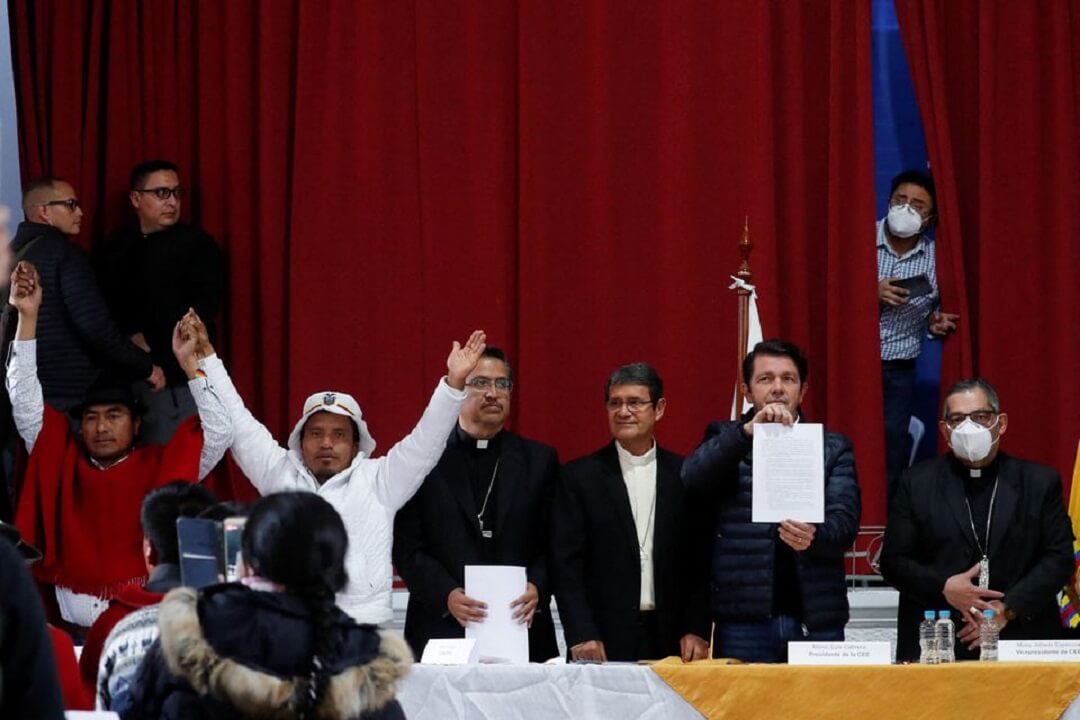Following 18 days of nationwide anti-government demonstrations in Ecuador that resulted in at least eight deaths, 150 arrests, and hundreds of injuries to both civilians and security personnel, Indigenous leaders on Thursday finalised a Peace Agreement with the government, effectively suspending the protests after the state made further concessions.
President Guillermo Lasso hailed the deal for successfully achieving “the supreme value to which we all aspire: peace in our country.” He said that now that the strike has ended, his government can go back to “the task of transforming this peace into progress, well-being, and opportunities for all.”
In a video, he said it is now time to tend to wounds and overcome divisions to work towards a “common objective” of “reconstructing” Ecuador. He noted that it is imperative to recover lost time to confront the challenges ahead. He also thanked the Catholic Church for its mediation efforts.
The agreement was signed by Minister of Government Francisco Jiménez, Confederation of Indigenous Nationalities of Ecuador (CONAIE) leader Leonidas Iza, Episcopal Conference chief Monsignor Luis Cabrera, who mediated the negotiations. Council of Evangelical Indigenous Peoples and Organizations of Ecuador (Feine) leader Eustaquio Tuala and National Confederation of Peasant, Indigenous, and Black Organizations (Fenocin) leader Gary Espinoza also agreed to the terms.
Firmamos el “Acta por la Paz” con la que se da fin al paro y se hace un llamado por la convivencia pacífica, el orden público, el desarrollo económico del país y la reconciliación nacional.
— Francisco Jiménez S. (@panchojimenezs) June 30, 2022
Hoy no hay ganadores ni perdedores individuales, hoy el único ganador es el Ecuador🇪🇨💪🏾💪🏻 pic.twitter.com/Us18HM4f0l
Thursday’s deal brought fuel prices down by a further $0.05 per gallon, effectively reducing it by a total of 15 cents, and respectively decreasing the price of gasoline and diesel to $2.40 and $1.75 per gallon, which still falls short of what the protesters had initially demanded. These price cuts are expected to cost the government around $340 million a year. Furthermore, it orders governors to intensify price controls in the country.
It also promises to reform Decree 151 in order to curb mining activities in protected environmental areas, national parks, archaeological zones, and water sources, while halting a further expansion of oilfields. Crucially, it provides Indigenous communities the right to be consulted on such developments.
However, the Lasso government simultaneously underscored its continued commitment to repealing Decree 95, which “reduced the State’s participation in oil activities and promoted international bidding processes for oil fields.”
Furthermore, the government agreed to repeal the “state of emergency” imposed in four of the country’s 24 provinces.
Finally, the Lasso administration placed the health system in the country under an emergency, and called for compensatory policies for urban and rural sectors.
Any further issues raised by the demonstrators will be addressed via dialogue within the next 90 days, with the government required to deliver on its promises within the intervening period.
The deal thus outlined a path for the “cessation of the mobilisations and the gradual return [of the demonstrators] to the territories” from where they came to join the march.
🇪🇨✊🏾 ¡Solo la lucha nos ha permitido conquistar derechos!
— CONAIE (@CONAIE_Ecuador) June 30, 2022
Sí tenemos resultados en la agenda nacional de 10 puntos, sí logramos medidas para aliviar la situación económica, salud y educación de las familias vulnerables del campo y ciudad; bajamos decretos para defender la vida. pic.twitter.com/paEpM030za
Iza welcomed the peace deal but vowed to “keep fighting” for the betterment of the people, noting that certain demands remain unfulfilled.
In fact, Episcopal Conference chief Cabrera warned that “if state policies do not resolve the problem of the poor, then the people will rise up” again. To this end, he called for “particular attention ( to be) paid to marginalised communities” in order to achieve lasting social peace in the country.
Talks between Indigenous leaders and the Lasso government first started on Monday and later resumed on Wednesday after having been briefly suspended following a deadly attack that killed one soldier and left 12 security personnel injured in Shushufindi on Tuesday. The government had accused the protesters of orchestrating the attack and refused to negotiate with those who held the country “hostage.” However, it later agreed to talks so long as they were mediated by the Episcopal Conference.
Lasso also survived an impeachment attempt on Tuesday.
Roughly 14,000 people, mainly Indigenous inhabitants, had been protesting against the government’s social and economic policies since June 13, demanding fuel price cuts, food price controls, increased public expenditure on health and education, guarantees against new oil and mining projects, a debt moratorium for poor families, better employment opportunities, and subsidies for small farmers.
The protests resulted in road blockades and shortages of food, fuel, and critical medical supplies across the country, despite calls by CONAIE to allow the transit of products for domestic use.
In fact, the prolonged unrest caused $213 million in losses to the country’s oil sector, with state run Petroecuador suspending services for over nine days after declaring a force majeure. In fact, just this Sunday, it said the country was on the verge of shutting down production entirely.
A peace deal brokering the suspension of demonstrations in the country is thus likely to aid economic recovery, with Energy Minister Xavier Vera expressing his satisfaction at the reopening of oil wells and the resumption of pre-protest levels of production (500,000 barrels per day) within the next month after suffering a more than 50% reduction in output due to the closure of over 1,200 wells.
The protests also negatively impacted the tourism sector, which suffered losses of up to $70 million over the last two weeks, according to the Minister of Tourism, Niels Olsen.

